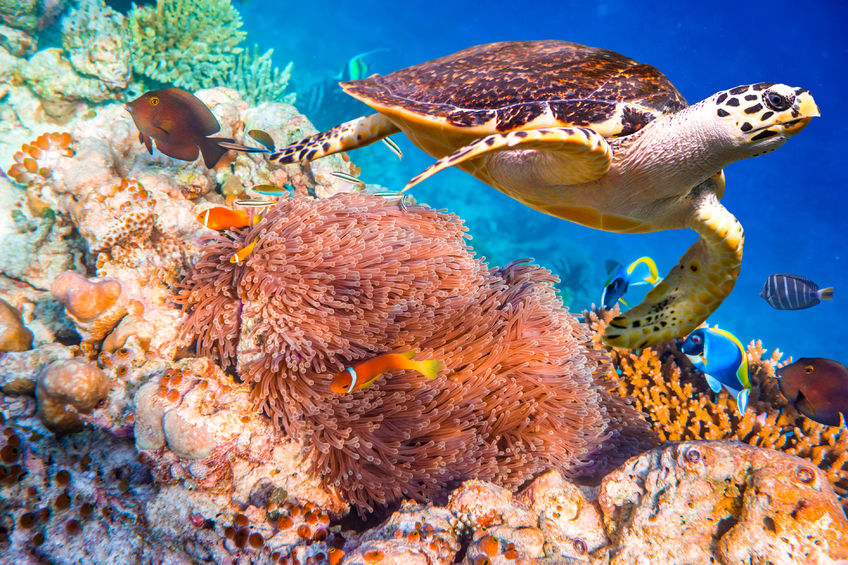Coral Reefs and the Efforts to Save Them
April 20, 2017
Coral reefs, known as the “rainforests of the sea,” are the most diverse marine ecosystems on the planet. According to the Smithsonian Ocean Portal, “Perhaps one quarter of all ocean species depend on reefs for food and shelter.”
But what exactly are corals reefs? To start with, corals are colonial organisms; this means that they are made up of hundreds of thousands of individual animals called polyps. There are several kinds of corals, including deep-water corals, soft corals, and stony corals that actually create reefs. These stony coral’s polyps secrete layers of calcium carbonate, which over millions of years build the reefs of today, according the Coral Reef Alliance.
However, the ocean’s coral reefs are dying off. In fact, according to Brian Clark Howard, writing in “National Geographic,” it was found that 50 percent of the Great Barrier Reef is dead due to coral bleaching which, according to the Australian government, is linked to rising ocean temperatures.
“Bleaching occurs when warm ocean water stresses corals to the point that they expel the tiny algae, known as zooxanthellae, that normally live inside their tissues,” Howard writes. Because this algae provides the coral with its color, bleached corals appear white.
Coral bleaching is not the only threat to these reefs, however. Another concern is the amount of carbon dioxide in the oceans. As more CO2 is pumped into the atmosphere by the burning of fossil fuels, more ends up in the oceans, making it more acidic, which in turn makes it harder for corals to build their hard outer skeletons.
So why do people care about the reefs? Why should they be saved? According to the World Wildlife Fund, the latest estimates have given coral reefs a value of $30 billion per year. This value is created through fisheries, tourisms, and coastal protection.
Reefs are like the nurseries of the ocean where baby fish are born and raised; without these areas, the fishing industry will no longer have fish to catch and sell. According to WWF, “An estimated one billion people have some dependence on coral reefs for food and income from fishing.”
As for tourism, according to a report by the Key West Chamber of Commerce, “Tourists visiting the Florida Keys in the U.S. generate at least $3 billion in [revenue], while Australia’s Great Barrier Reef generates well over $1 billion per year.” These reefs provide a vital source of income for these communities.
Reefs also break waves from hurricanes and other storms. This helps to prevent erosion and protect property, saving an estimated billion dollars every year worldwide.
The endangerment of the coral reefs is an international issue, but that doesn’t mean there are no local efforts to counter it. In fact, coral is being grown right here in New Mexico at the ABQ Biopark to save this threatened animal.
According to the city of Albuquerque’s website, the Biopark has 50 species of coral and about 800 specimens. Through this program, Albuquerque is working to raise awareness and sends corals to other aquariums so they can start their own programs.
Transplanting coral is another tactic. David Vaughan, director of the Mote Tropical Research Laboratory in Florida, is attempting to transplant new corals into existing reefs to help buy time as climate change is being addressed. Vaughan’s team has discovered that “When cut into small strips, the slow-growing living corals quickly try to heal themselves.” According to Christopher Page, a biologist with Vaughan’s team, by cutting the coral, “You’re actually stimulating it to grow.”
However, this team is not just babying these coral reefs to help them grow. They are actually creating the conditions in the coral tanks to match ocean conditions. This allows them to breed the toughest coral that are most likely to survive. According to Vaughan, they try to pick “which ones will be the winners and which ones will be the losers, so we’re always using the winners.”
While these are programs put together by large institutions to help the reefs, this doesn’t mean that everyday people can’t help. According to the Nature Conservancy, there are easy things to do to help the reefs. These include conserving water, planting trees to help reduce the runoff to the ocean that contains pollutants, choosing garden inputs that don’t pollute runoff, and simply spreading the word about the threats to our reefs.
These ecosystems have taken millions of years to develop and are filled with life. If we want these amazing areas to survive, we need an international movement, including everyone from massive corporations to you and me.


